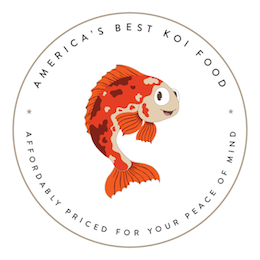The Art of Koi: Varieties and Symbolism March 22 2017, 2 Comments
Raising koi is a fun hobby, and a pond featuring these beautiful fish can be a delightful addition to your landscape. But, do you know the whole story of these living paintings? Many people think koi and goldfish are interchangeable, but they’re not. An easy way to distinguish the two: Koi have barbels or whiskers on their lip; goldfish don’t. Koi are ornamental varieties of the common carp that were originally domesticated in Eastern Asia in the early 400s (that’s not a typo!) as an important source of food.
It wasn’t until much later, around the 1820s, that the carp moved off the dinner plate and began being bred for their unique color variations. However, the general public wasn’t aware of the development of these stunning fish until 1914, when the Niigata koi were exhibited at an annual exposition in Tokyo. From then on, the hobby of keeping koi spread worldwide.
Types of Koi
Koi breeders have identified and named a number of specific categories of the fish based on color, pattern, and scale formation. The major colors of koi are white, black, red, yellow, blue, and cream, with more exotic colors such as solid metallic silver and gold being bred more recently.
The most notable and popular category of koi is Gosanke, which is made up of more than twenty varieties; however, you can find more than 120 varieties of koi if you look at other categories.
The most common koi are easily found by contacting breeders or farms and even stores such as Petco.
Kohaku, the oldest and most well-known variety of koi, have a solid white base with patterns of red overlaid on top of the white.
Showa Sanshoku, or just Showa, have white and red/orange patterns over a black base color that wraps around the body. Showa also has black patterns on its head.
Tancho is a hugely popular variation of Kohaku. The only red pattern on this fish is a single red dot on its head, which is symbolic of the Japanese flag.
Symbolism and Koi
A couple thousand years ago, a legend in China was formed that told how carp that swam up a waterfall and through the dragon gate were magically transformed into dragons. Through perseverance and endurance, the carp become mythical beings. Two thousand years later and the koi fish still symbolize perseverance and endurance, as well as strength and individualism.
Because koi can develop such variation in colors, it shouldn’t be a surprise that each color also has a specific connotation. Of course, gold koi such as Kigoi represent wealth and prosperity. Metallic koi such as Matsuba symbolize business success. A blue koi such as Asagi brings serenity and also symbolizes positivity. Black koi symbolize love and overcoming adversity.
One step you can take to ensure you keep a pond full of healthy, beautiful koi is to feed them the best koi fish food. Order economical koi food from America’s Best Koi Food today and give your fish the right diet to help them thrive.


Comments
discount cialis on August 21 2020 at 10:26PM
Expired Amoxicillin Clavulanic Potassium Tablets infisres https://apcialisz.com/ – cialis Effernignill Viagra Generika Cialis emable order cialis online spidly 500 Milligrams Keflex
buy cialis 20mg on July 22 2020 at 12:57PM
Nizagara Cheap embomomype https://bbuycialisss.com/# – canadian pharmacy cialis sifsTixKeree Amoxicillin 500mg Times A Day cryday Cialis apeweetelf Can Keflex Cure Chlamydia